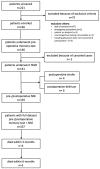Association between Neuron-Specific Enolase, Memory Function, and Postoperative Delirium after Transfemoral Aortic Valve Replacement
- PMID: 37998499
- PMCID: PMC10672434
- DOI: 10.3390/jcdd10110441
Association between Neuron-Specific Enolase, Memory Function, and Postoperative Delirium after Transfemoral Aortic Valve Replacement
Abstract
Introduction: Although transfemoral aortic valve replacement (TAVR) is a safe treatment for elderly patients with severe aortic valve stenosis, postoperative microembolism has been described. In this secondary endpoint analysis of the POST-TAVR trial, we aimed to investigate whether changes in neuron-specific enolase (NSE)-a biomarker of neuronal damage-are associated with changes in memory function or postoperative delirium (POD).
Materials and methods: This was a prospective single-center study enrolling patients undergoing elective TAVR. Serum NSE was measured before and 24 h after TAVR. POD was diagnosed using CAM-ICU testing. Memory function was assessed before TAVR and before hospital discharge using the "Consortium to Establish a Registry for Alzheimer's Disease" (CERAD) word list and the digit span task (DST) implemented in "∆elta-App".
Results: Subjects' median age was 82 years (25th to 75th percentile: 77.5-85.0), 42.6% of subjects were women. CERAD scores significantly increased from pre- to post-TAVR, with p < 0.001. POD occurred in 4.4% (6/135) of subjects at median 2 days after TAVR. After TAVR, NSE increased from a median of 1.85 ng/mL (1.30-2.53) to 2.37 ng/mL (1.69-3.07), p < 0.001. The median increase in NSE was 40.4% (13.1-138.0) in patients with POD versus 17.3% (3.3-43.4) in those without POD (p = 0.17).
Conclusions: Memory function improved after TAVR, likely due to learning effects, with no association to change in NSE. Patients with POD appear to have significantly higher postoperative levels of NSE compared to patients without POD after TAVR. This finding suggests that neuronal damage, as indicated by NSE elevation, may not significantly impair assessed memory function after TAVR.
Keywords: TAVR; cognitive assessment; memory function; neuron-specific enolase; postoperative delirium.
Conflict of interest statement
The authors have no relevant affiliations or financial involvement with any organization or entity with a financial interest in or financial conflict with the subject matter or materials discussed in the manuscript. This includes employment, consultancies, honoraria, stock ownership or options, expert testimony, grants or patents received or pending, or royalties.
Figures



Similar articles
-
App-based assessment of memory functions in patients after transfemoral aortic valve replacement.J Geriatr Cardiol. 2023 Sep 28;20(9):664-672. doi: 10.26599/1671-5411.2023.09.004. J Geriatr Cardiol. 2023. PMID: 37840630 Free PMC article.
-
Incidence, Predictive Factors, and Effect of Delirium After Transcatheter Aortic Valve Replacement.JACC Cardiovasc Interv. 2016 Jan 25;9(2):160-8. doi: 10.1016/j.jcin.2015.09.037. JACC Cardiovasc Interv. 2016. PMID: 26793958
-
Risk factors and outcome of postoperative delirium after transcatheter aortic valve replacement.Clin Res Cardiol. 2018 Sep;107(9):756-762. doi: 10.1007/s00392-018-1241-3. Epub 2018 Apr 13. Clin Res Cardiol. 2018. PMID: 29654435
-
Delirium is associated with higher mortality in transcatheter aortic valve replacement: systemic review and meta-analysis.Cardiovasc Interv Ther. 2020 Apr;35(2):168-176. doi: 10.1007/s12928-019-00592-y. Epub 2019 Jun 1. Cardiovasc Interv Ther. 2020. PMID: 31154617
-
Postoperative Delirium in Individuals Undergoing Transcatheter Aortic Valve Replacement: A Systematic Review and Meta-Analysis.J Am Geriatr Soc. 2018 Dec;66(12):2417-2424. doi: 10.1111/jgs.15600. Epub 2018 Oct 8. J Am Geriatr Soc. 2018. PMID: 30296342
Cited by
-
Accumulating the key proteomic signatures associated with delirium: Evidence from systematic review.PLoS One. 2024 Dec 19;19(12):e0309827. doi: 10.1371/journal.pone.0309827. eCollection 2024. PLoS One. 2024. PMID: 39700095 Free PMC article.
-
Clinical biomarkers of perioperative neurocognitive disorder: initiation and recommendation.Sci China Life Sci. 2025 Jul;68(7):1912-1940. doi: 10.1007/s11427-024-2797-x. Epub 2025 Jan 22. Sci China Life Sci. 2025. PMID: 39918707 Review.
-
The Pathophysiology and Biomarkers of Delirium.Semin Neurol. 2024 Dec;44(6):720-731. doi: 10.1055/s-0044-1791666. Epub 2024 Oct 17. Semin Neurol. 2024. PMID: 39419070 Free PMC article. Review.
-
Regional Cerebral Blood Flow Increase After Transcatheter Aortic Valve Replacement Is Related to Cardiac Output but Is Not Associated with Delirium: An Observational Cohort Study Using Transcranial Indocyanine Green Dye Dilution Technique.J Clin Med. 2025 Jun 17;14(12):4317. doi: 10.3390/jcm14124317. J Clin Med. 2025. PMID: 40566060 Free PMC article.
References
-
- Kahlert P., Al-Rashid F., Dottger P., Mori K., Plicht B., Wendt D., Bergmann L., Kottenberg E., Schlamann M., Mummel P., et al. Cerebral embolization during transcatheter aortic valve im-plantation: A transcranial Doppler study. Circulation. 2012;126:1245–1255. doi: 10.1161/CIRCULATIONAHA.112.092544. - DOI - PubMed
-
- Fanning J.P., Wesley A.J., Platts D.G., Walters D.L., Eeles E.M., Seco M., Tronstad O., Strugnell W., Barnett A.G., Clarke A.J., et al. The silent and apparent neurological injury in transcatheter aortic valve implantation study (SANITY): Concept, design and rationale. BMC Cardiovasc. Disord. 2014;14:45. doi: 10.1186/1471-2261-14-45. - DOI - PMC - PubMed
-
- Ghanem A., Muller A., Nahle C.P., Kocurek J., Werner N., Hammerstingl C., Schild H.H., Schwab J.O., Mellert F., Fimmers R., et al. Risk and fate of cerebral embolism after transfemoral aortic valve implantation: A prospective pilot study with diffusion-weighted magnetic resonance imaging. J. Am. Coll. Cardiol. 2010;55:1427–1432. doi: 10.1016/j.jacc.2009.12.026. - DOI - PubMed
LinkOut - more resources
Full Text Sources

